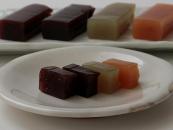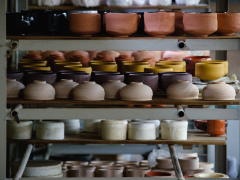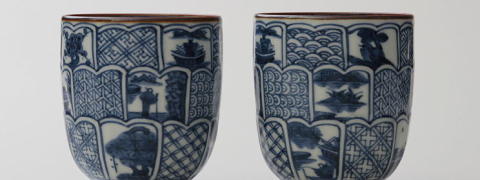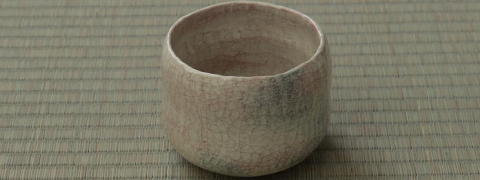| RAKU YAKI Prestigious Bowl |
 |
| - The History of the Raku Family |
|
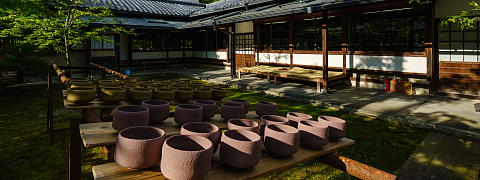 |
| Main Topic |
 |
| Seasonal Topics & Items |
 |
 |
| Dear Sir and Madam, |
 |
| We at Hibiki-an THANK YOU VERY MUCH for your continued patronage and support.
We are pleased to offer useful information for your healthy life and continued
enjoyment of Japanese green tea. In this issue, we talk about 'The History of the Raku Family - Pedigree Potter of Raku-yaki'. |
 |
 |
The History of the Raku Family - Pedigree Potter of Raku-yaki
|
 |
In the 16th century, Cha-no-yu traditional tea ceremony was regarded as a status symbol and as a way to enhance a sense of presence as an upper-class cultural value. Sen no Rikyuh, who was an attendant of the ruling class in Japan, asked Chohjiroh, a tile-maker at that time, to produce Raku-yaki to create the most suitable Matcha bowl for tea ceremony. Raku-yaki was born specifically to serve Matcha and aesthetically designed to embody Wabi-cha, which is the style of tea associated with the aesthetic sense of rustic simplicity, perfected by Sen no Rikyuh.
Raku-yaki was initially called Ima-yaki, which means "now ware" in Japanese since it was quite avant-garde and novel at that time. Raku-yaki was subsequently renamed Juraku-yaki due to the fact that the Raku home was nearby the Jurakudai palace and also Sen no Rikyuh lived inside the premises of the palace. Juraku-yaki was eventually abbreviated as Raku-yaki.
Since the age of Chohjiroh, the founder of Raku-yaki, the tradition of Raku-yaki has been handed down across successive generations to the present head, 15th generation Kichizaemon. For more than 450 years, successive generations have passed down the technique and tradition of Raku-yaki without any modification. The methods have remained the same since the birth of Raku-yaki. However, it is thought that the tradition is not only to follow in the footsteps of predecessors, but to build upon the history of the Raku family and to innovate. Each generation's goal was to produce avant-garde and novel works to surpass their predecessors. Therefore, excellent and remarkable works were successively produced and the great tradition remains. |
 |
Representative head of the Raku family and the persons concerned |
 |
Chohjiroh, the founder (? - 1589)
Chohjiroh founded Raku-yaki under the guidance of Sen no Rikyuh, who established Wabi-cha. His unique works reflect most directly the ideals of WABI SABI affected by Sen no Rikyuh. His works are quite simple, since he negated movement, decoration and variation of form and individuality. However, his works have intense presence. |
 |
 |
 |
 |
SHUNKAN
His unique work reflects directly the ideals of WABI SABI.
Source of photo (Cultural Heritage Online): http://bunka.nii.ac.jp/index.php |
|
 |
 |
 |
TAROHBOH
His work is quite simple.
Source of photo (Cultural Heritage Online): http://bunka.nii.ac.jp/index.php |
|
 |
 |
 |
NISAISHISHI
Source of photo (Raku museum HP): http://www.raku-yaki.or.jp/index.html |
|
 |
 |
Johkei, the second generation (? - 1635)
After the death of Chohjiroh, he directed the Raku workshop and founded the base of the Raku-yaki continuing until today. Since the age of Johkei, each generation has succeeded to the name "Kichizaemon". His work has more movement and variation of form, which was never found in the works of Chohjiroh. |
 |
 |
 |
 |
KUROKI
His work has more movement and variation of form.
Source of photo (Raku museum HP): http://www.raku-yaki.or.jp/index.html |
|
 |
 |
 |
KIKUMON
Source of photo (Raku museum HP): http://www.raku-yaki.or.jp/index.html |
|
 |
 |
 |
YUHSAISHISHI
Source of photo (Raku museum HP): http://www.raku-yaki.or.jp/index.html |
|
 |
 |
Nonkoh, the third generation (1599 - 1656)
Born the eldest son of Johkei, he is also known as Dohnyu and considered as the most skillful potter of the Raku family. He was in close friendship with Kohetsu Honami and it is said that his novel works were affected by Kohetsu. He introduced the decorativeness and spontaneous individuality into the tradition of Chohjiroh that eliminated decoration especially by the application of white or transparent glazes on top of the black glaze. |
 |
 |
 |
 |
KINOSHITA
NONKOH is considered as the most skillful potter of the Raku family.
Source of photo (Raku museum HP): http://www.raku-yaki.or.jp/index.html |
|
 |
 |
 |
SOHJYOH
He introduced decorativeness and spontaneous individuality into the tradition of Chohjiroh.
Source of photo (Raku museum HP): http://www.raku-yaki.or.jp/index.html |
|
 |
 |
 |
NUE
It is said that his novel works were affected by Kohetsu.
Source of photo (Cultural Heritage Online): http://bunka.nii.ac.jp/index.php |
|
 |
 |
Kohetsu Honami (1558 - 1637)
Kohetsu Honami was born into a prominent merchant family in Kyoto professionally engaged in the forging and connoisseurship of swords. He was a typical man of culture of his period, developing various cultural activities. In 1615, Kohetsu started making Raku-yaki assisted by Johkei and Nonkoh. His works are known for their spontaneity absent of restriction. |
 |
 |
 |
 |
MURAKUMO
His works are known for their spontaneity absent of restriction.
Source of photo (Raku museum HP): http://www.raku-yaki.or.jp/index.html |
|
 |
 |
 |
TATSUMINE
Source of photo (Raku museum HP): http://www.raku-yaki.or.jp/index.html |
|
 |
 |
 |
FUJISAN
Source of photo (Sunritz Hattori museum HP): http://www.sunritz-hattori-museum.or.jp/ |
|
 |
 |
 |
 |
 |
 |
Aka-raku TSUTSUCHAWAN
Source of photo (Cultural Heritage Online): http://bunka.nii.ac.jp/index.php |
|
 |
 |
 |
Kohetsu Honami
Kohetsu Honami who is known as the Japanese Leonardo da Vinci because he mastered various fields. |
|
 |
 |
 |
Letter written by Kohetsu
Letter written by Kohetsu to Johkei, short and simple text is showing their close relationship.
Source of photo (Raku museum HP): http://www.raku-yaki.or.jp/index.html |
|
 |
 |
Keinyuh, the eleventh generation (1817 - 1902)
He was adopted into the Raku family as son-in-law and succeeded as the 11th generation in 1845. The period he lived through was an age of transition from feudalism to the modernization introducing the modern cultural prospects from the West, as traditions like tea culture steadily declined. Under such unfavorable circumstances, Keinyuh vigorously made a variety of works which are supported by high quality of artifice as well as a poetic sensibility. |
 |
 |
 |
 |
Kuro-raku by Keinyuh
Keinyuh made a variety of works supported by high quality of artifice and a poetic sensibility.
Source of photo (Raku museum HP): http://www.raku-yaki.or.jp/index.html |
|
 |
 |
 |
Aka-raku by Keinyuh
Source of photo (Raku museum HP): http://www.raku-yaki.or.jp/index.html |
|
 |
 |
 |
Incense burner in shape of goose
Source of photo (Raku museum HP): http://www.raku-yaki.or.jp/index.html |
|
 |
 |
Kichizaemon, the present head of Raku family (1949 - )
After he graduated from the Sculptural Department at the Tokyo University of Fine Arts in 1973, he went to Italy for further studies. He succeeded as the 15th generation Kichizaemon in 1981. He stepped further forward in the modern interpretation of Raku-yaki, though keeping the fundamentals of the tradition. His avant-garde style is characterized by the sculptural modeling achieved by bold trimming. |
 |
 |
 |
 |
SHUHGIKU
Kichizaemon stepped further forward in the modern interpretation of Raku-yaki.
Source of photo (Raku museum HP): http://www.raku-yaki.or.jp/index.html |
|
 |
 |
 |
JYOKA
Source of photo (Raku museum HP): http://www.raku-yaki.or.jp/index.html |
|
 |
 |
 |
RIKA
His avant-garde style is characterized by the sculptural modeling achieved by bold trimming.
Source of photo (Raku museum HP): http://www.raku-yaki.or.jp/index.html |
|
 |
 |
 |
 |
 |
 |
Kichizaemon Pavilion
He also designed architecture and tea room of Kichizaemon Pavilion at Sagawa Art Museum.
Source of photo (Sagawa Art Museum HP): http://www.sagawa-artmuseum.or.jp/ |
|
 |
 |
 |
Tea room designed by Kichizaemon
Source of photo (Sagawa Art Museum HP): http://www.sagawa-artmuseum.or.jp/ |
|
 |
 |
 |
Tea room designed by Kichizaemon
Source of photo (Sagawa Art Museum HP): http://www.sagawa-artmuseum.or.jp/ |
|
 |
 |
 |
| Prestigious RAKU YAKI (Matcha Bowl) shopping category: click here |
| RAKU YAKI - Prestigious Bowl page: click here |
 |
 |
 |
What is Shouraku / Kirai-kiln?
|
 |
In 1995, Teruo Sasaki, who was the third potter of Shouraku Kiln, opened a kiln under the name of "Kirai" and the name of "Kyoshitsu" which was given by the fourteenth chief administrator of Daitokuji temple*, Settei Fukutomi Roushi master.
The Sasaki family is well-known for their traditional Raku-yaki at Shouraku Kiln. Shouraku Kiln opened in 1903, and is one of the most traditional Raku-yaki kilns in Kyoto. Yamato Sasaki, who is the son of Teruo Sasaki and the fourth head of Shouraku Kiln, succeeded to Kyoshitsu the second in 2011.
Kirai Kiln produces avant-garde and novel works which are not restricted by traditional style, while still adhering to traditional Raku-yaki techniques. Shouraku Kiln, on the other hand, strictly follows the footsteps and traditional methods of Raku-yaki.
(*) Daitokuji temple was erected in 1325. The temple has had a great influence on Japanese culture and Cha-no-yu traditional tea ceremony, since the spirit of Cha-no-yu is based in Zen philosophy. It is also said that Juko Murata or Sen no Rikyuh, who is the famous tea master and pioneer of the tea ceremony, maintained close relations with Daitokuji temple. |
 |
 |
| Prestigious RAKU YAKI (Matcha Bowl) shopping category: click here |
| RAKU YAKI - Prestigious Bowl page: click here |
 |
 |
 |
Prestigious RAKU YAKI (Matcha Bowl): Now Available |
 |
We, Hibiki-an have collaborated with Kyoshitsu Sasaki at Kirai Kiln which produces avant-garde and novel Raku-yaki not restricted by traditional style while still adhering to traditional techniques. Raku-yaki is regarded as the most prestigious and highest ranked earthenware in the tea ceremony.
This time, we are fortunate to be able to offer two pieces of Raku-yaki which is one-of-a-kind item and three limited Matcha Bowls made by Kyoshitsu Sasaki at Kirai Kiln. You will be fascinated by the world of Raku-yaki and the artisan Kyoshitsu Sasaki. |
 |
One-of-a-kind pieces |
 |
 |
 |
 |
[KIRAI] KURO CHAWAN - SHINGETSU (by Kyoshitsu Sasaki II): US$2,980.00
(One-of-a-kind piece / Now Available)
Another one-of-a-kind piece was sold out as soon as we released, so we have released new one-of-a-kind piece in response to requests from our customers.
SHINGETSU means pure heart in Japanese. Boldly scraped sides and asymmetric shape create divinity and dynamism of this work. Discoloration, including reddish brown, whitish gray and blue color with gold leaf modestly and gracefully pasted, creates mysterious atmosphere. It looks like the Milky Way on the beautiful pitch-black surface... |
 |
 |
 |
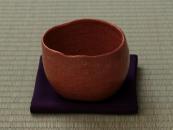 |
 |
[KIRAI] AKA CHAWAN - YUHSEI (by Kyoshitsu Sasaki II): US$2,780.00
(One-of-a-kind piece / Now Available)
YUHSEI means quaint and elegant in Japanese and it also indicates a state of quiet calm. The artisan Kyoshitsu expresses simplicity and softness on this work. Just as he imagined, the shape is naturally rounded and the bowl is colored in a refined and warm coral. This work is so noble that it makes us feel as though time stops... |
 |
 |
Limited Matcha bowls (From October 2017 to September 2018) |
 |
 |
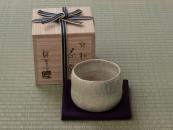 |
 |
[KIRAI] SHIROYU CHAWAN - UNHOH (handcrafted Matcha Bowl): US$1,085.00
(Limited from Oct. 2017 to Sept. 2018 / Now Available)
UNHOH means clouded peaks. This bowl is characterized by the unique color which is created by blending transparent glaze used for Aka-raku and white glaze. The form is inspired by Chohjiroh, the first generation in the Raku family line of potters. The form is quite simple since Raku-yaki was produced only for the tea ceremony... |
 |
 |
 |
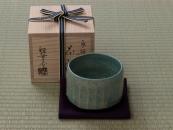 |
 |
[KIRAI] HANADAYU CHAWAN - SEIRYOHRYOH (handcrafted): US$1,085.00
(Limited from Oct. 2017 to Sept. 2018 / Now Available)
SEIRYOHRYOH means quite pure and refined in Japanese. This bowl is characterized by the refined sky blue color, produced by turquoise blue glaze, and the unique form, boldly cut away, which evokes the impression of a valuable gemstone. KANNYU cracking adds a fantastic and mysterious atmosphere... |
 |
 |
 |
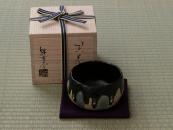 |
 |
[KIRAI] KURO CHAWAN - SHINKOH (handcrafted Matcha Bowl): US$1,085.00
(Limited from Oct. 2017 to Sept. 2018 / Now Available)
SHINKOH means extraordinarily auspicious in Japanese. This bowl is characterized by the fresh and vivid color contrast on the surface. Each color is well-harmonized and evokes a modern and sophisticated atmosphere; it is a work of art. Conversely, the inside of this bowl is simply all black like traditional Kuro-raku black Raku-yaki... |
 |
 |
 |
| Are you enjoying your green moments? Hibiki-an encourages those who love to drink green tea. If you have any requests or questions regarding our teas or services, please don't hesitate to contact us. We sincerely hope that you enjoy genuine Hibiki-an Japanese green tea direct to you from Kyoto, Japan. |
 |
| Sincerely yours, |
 |
| Atsushi Yasui |
Seasonal Topics & Items
|
 |
 |
 |
 |
[Limited] Snacks and Candy (Winter) |
 |
We at Hibiki-an added seven Japanese confectioneries which are all
only available in winter. Our carefully selected items for winter confections
amuse your mouth very much, and perfectly match with Japanese green tea.
Japanese traditional confection of MONAKA and KUROMAME glace provide their
original texture and flavor. Kuzu Balls and apple/sweet potato chips are
uniquely airy pleasant flavor. MATCHA KINAKO Balls and KOUJI SOBA BOLO
has light texture and those aroma linger in your mouth. Rich flavor and mellow aroma of Matcha chocolate lingers on the palate and has a lovely finish.
We are certain that they will all completely please your taste bud. Please take a look! |
 |
Winter Confections |
 |
| Japanese Snacks / Candy Shopping category: click here |
 |
 |
This Month's Tea - Karigane |
 |
| We would like you to rediscover the value of our Karigane teas for monthly recommendation. Karigane is less expensive than tea leaves because it is a by-product. It is made from the stems of Gyokuro and high grade Sencha. You are sure to delight in the excellent value of Karigane. At the same time we arranged a special Karigane tea, Gyokuro Karigane Super Premium. It is the limited edition of 450 packages only available this early spring season. |
 |
Special Karigane (Limited) |
 |
 |
 |
 |
[Limited] Gyokuro Karigane Super Premium (40g/1.41oz): US$18.00
(Now Available: limited edition of 450 packages ONLY AVAILABLE in early spring this year)
Gyokuro Karigane Super Premium is an excellent value. Because it is made from the stems and veins of the only highest-quality Gyokuro, such as Gyokuro Pinnacle and Kuradashi Gyokuro Pinnacle, you can have the quality of Premium for a fraction of the cost... |
 |
 |
Regular Karigane and Other |
 |
 |
 |
 |
Gyokuro Karigane Premium (100g/3.53oz): US$22.00
Gyokuro Karigane Premium which is made from the stems of highest grade Gyokuro is very valuable and precious. You can enjoy the excellent flavor of high grade Gyokuro at an affordable price... |
 |
 |
 |
 |
 |
Sencha Karigane (200g/7.06oz): US$23.00
Sencha Karigane Premium which is made from the stems of high grade Sencha is valuable and precious. Karigane contains much Theanine which is the source of its sweet and mellow taste... |
 |
 |
 |
 |
 |
Houjicha Karigane (200g/7.06oz): US$19.00
Houjicha Karigane is made from the stems of high grade tea leaves and roasted in the same way as standard Houjicha. The flavor is deeply sweet and roasted, which is quite unique among Japanese tea... |
 |
 |
 |
 |
Special Houjicha Teas: Limited / Now Available! |
 |
We would like you to rediscover the value of our Houjicha items for monthly recommendation. You are sure to delight in the unique sweet and roasted flavor of Houjicha. The flavor is very smooth and the aroma lingers nicely for a while.
At the same time we arranged two special Houjicha items, Houjicha Super Premium and Houjicha Karigane Super Premium. Each item is the limited edition of 450 packages only available this winter season.
|
 |
Special Houjicha (Limites) |
 |
 |
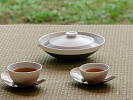 |
 |
[Limited] Houjicha Super Premium (100g/3.53oz): US$15.00
(Now Available: limited edition of 450 packages ONLY AVAILABLE this winter season)
To make this Houjicha Super Premium, we use only young sprouts. And a small amount of stems from the highest grade Matcha are added in order to create the unique noble aroma... |
 |
 |
 |
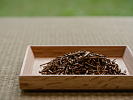 |
 |
[Limited] Houjicha Karigane Super Premium (100g/3.53oz): US$14.00
(Now Available: limited edition of 450 packages ONLY AVAILABLE this winter season)
The stems contained in this tea are usually used for Sencha Karigane, not Houjicha Karigane. Stems from the highest grade Matcha are added in order to create the unique noble aroma... |
 |
 |
 |
 |
[New & Limited] Teapots / Cups, Matcha Bowls / Accessories |
 |
| We have arranged for 27 limited edition and new teapots / cups, and 16
limited edition and new Matcha Bowls / Accessories. The 43 limited edition
items are all available only this autumn and winter season. |
 |
| Teapots / Cups shopping category: click here |
| Matcha Bowls / Accessories shopping category: click here |
 |
 |
 |
 |
Account info
You can view your account info, including your order history, as well as change your email, password, or home address or add a new shipping address to your address book by clicking here.
Or if you prefer, we are happy to update your account info for you. Just let us know. Please don't hesitate to contact us!
|
 |
To unsubscribe from Hibiki-an Newsletters
You can remove your email address from the mailing list by clicking here.
Or if you prefer, email us with your FULL NAME and we will immediately remove your email address from the mailing list.
|
|
 |
 |
|
|











